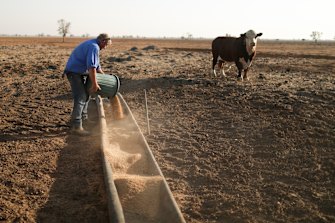The run-up to the 2019 federal election was dominated by the Coalition’s scare campaign over the cost of Labor’s more ambitious climate policy. Three years on, the public and business community want greater climate action and the major parties are competing over who has the best plan to reach net zero emissions.
But the reality is both parties’ climate commitments fall short of what’s needed to meet Australia’s commitment to the 2015 Paris Agreement, under which countries pledged to collective action that would limit global warming to as close to 1.5 degrees on pre-industrial levels as possible.
Climate action is among the key issues for many voters this election campaign.Credit:Alex Ellinghausen.
But countries around the world aren’t cutting greenhouse emissions fast enough and it’s almost inevitable that global warming will exceed 1.5 degrees, and only deeper cuts will stop 2 degrees of warming.
Analysis by the Climate Analytics think tank, released this week, found Australia’s emissions reduction plans, formed by the Coalition over the past three years, would fall short of the 1.5-degree target by a “considerable margin”.
The Coalition has ruled out forcing polluters to cut emissions and instead is focused on funding research and development to lower the cost, and drive the take-up, of clean technologies. It has pledged to cut emissions by at least 26 per cent by 2030 and to hit net zero by 2050.
Climate Analytics found if the rest of the world also adopted the Coalition’s targets, the global average temperature rise would exceed 3 degrees.
Labor has committed to cut emissions 43 per cent by 2030 and hit net zero by 2050. It has a plan to tighten restrictions on the 215 biggest polluting facilities such as mines and smelters and to pump $20 billion into the electricity grid so it can take more renewable energy.
Despite the plan to tackle industrial pollution, however, Climate Analytics found if the rest of the world followed Labor’s path, global warming would exceed 2 degrees.
The Greens’ 2030 target of a 74 per cent emissions reduction by 2030 and net zero by 2050, including a ban on coal mining and power by 2030, was consistent with limiting the global average temperature rise to 1.5 degrees.
Targets for emissions cuts of at least 60 per cent within the decade spruiked by prominent independent candidates such as Zali Steggall, Allegra Spender and Monique Ryan would also keep warming to 1.5 degrees, the analysis found.
Climate action is among the key issues for many voters this election campaign. They are taking on board scientists’ warnings that there is a crucial difference between what would happen to people and the planet under 1.5 and 2 degrees of global warming.
At 1.5 degrees of warming, the Great Barrier Reef would shrink by 70 to 90 per cent, while at 2 degrees, just 1 per cent of the reef would survive, according to the Australian Academy of Science.
The United Nations’ Intergovernmental Panel on Climate Change found droughts would become more frequent and intense under 2 degrees of warming, while limiting the temperature rise to 1.5 degrees would mean 50 per cent fewer people around the world would suffer water shortages.
Under 1.5 degrees, 14 per cent of the global population would be exposed to extreme heat in one year out of five, rising to 37 per cent of people with 2 degrees of warming.
The Coalition points to Australia’s 20 per cent reduction in emissions since 2005.
But like several previous analyses, Climate Analytics found 18 per cent of Australia’s emissions cuts have come from restrictions on tree clearing. Another 6 per cent saving was achieved in the electricity sector, where polluting coal- and gas-powered electricity is being replaced by solar and wind farms.
On the other side of the carbon ledger, emissions from industries outside the energy sector, such as mining, manufacturing and transport rose by a cumulative 4 per cent, bringing the overall emissions reduction down to 20 per cent.
Most nations don’t rely on tree clearing for their emissions savings – the average emissions across the OECD have fallen 14 per cent without tree clearing, including 34 per cent in the UK and 21 per cent in the European Union.
International rules count tree clearing as a source of emissions, which means if fewer trees are cleared a country can claim it as emissions reduction.
NSW and Queensland state governments changed laws that restricted land clearing in the early 2000s, which means Australia can count significant emissions savings when the post-2005 rate of clearing is compared to the historical rate before the tighter laws came into place.
Cut through the noise of the federal election campaign with news, views and expert analysis from Jacqueline Maley. Sign up to our Australia Votes 2022 newsletter here.
Most Viewed in Politics
From our partners
Source: Read Full Article
